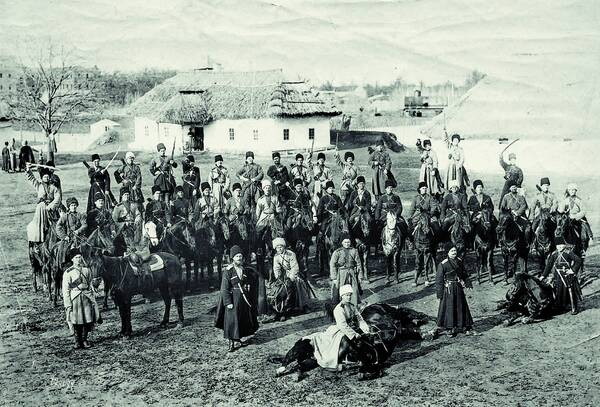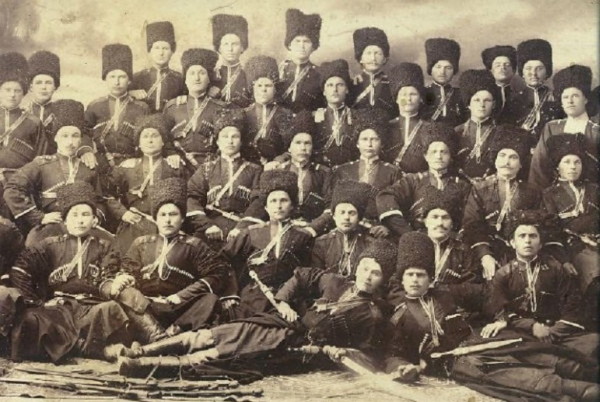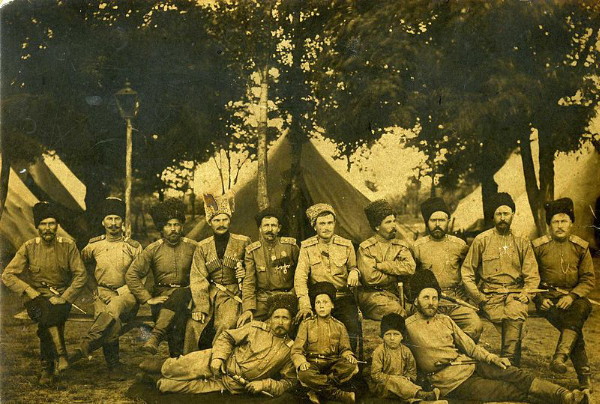Kuban Cossack Host
Kuban Cossack Host. The only formation of Ukrainian Cossacks that existed until the final days of tsarist rule, and one of the 12 Cossack armies in the Russian Empire. The Kuban Cossack Host was created in 1860 out of the Black Sea Cossacks, the remnants of the Zaporozhian Cossacks, and the six western units of the Frontier Army. Numbering 400,000 people in 1860, by 1912 the total number had grown to 1,392,000 (including both Cossacks and their families). While the Black Sea Cossacks had originally enjoyed considerable autonomy and were permitted to retain Zaporozhian traditions and practices, these rights were increasingly restricted in the early 19th century. The organization of the Kuban host was modeled after that of Russian Cossack hosts, and regular Russian army institutions and discipline were slowly introduced. Election of senior officers was not allowed, and the host was usually headed by a Russian general appointed by the government. He took the title of acting otaman and also exercised civilian authority in the Kuban provincial government. Autonomy was limited to the stanytsia (garrison) level, where officers, including the local otaman, his staff, and judges, were elected.
Military training for the Cossacks was very demanding. It included three years of basic training in the stanytsias, four years of active service in the various regiments, four years in the reserve units with annual summer exercises, four years in secondary reserve units with one major exercise during that period, and five years in the general reserve corps, when the Cossacks could be mobilized in an emergency. The Cossacks provided their own uniforms, swords, and horses. Compared to other Cossack armies, the Kuban host mobilized many units. In 1860 it mustered 22 cavalry regiments, 3 cavalry squadrons, 13 scout (plastun) battalions, and 5 artillery batteries. Later, Kuban Cossacks were often posted in Warsaw and elsewhere in the empire to suppress revolts and serve as special guard units. In 1914 the host comprised 37 cavalry regiments, 22 plastun battalions, 6 artillery batteries, and 47 various other units, for a total of about 90,000 men in active service.
At first, landownership was determined according to the traditions of the Zaporozhian Cossacks. The host was granted 7.4 million ha of land out of the 9.4 million ha in the entire province. The host then divided this land among the stanytsias. Every Cossack over 16 years of age was guaranteed his own plot of land, and a tenth of the land remained in reserve for later distribution. Periodically the land was redistributed, based on need. Land was especially plentiful after Russia acquired the area to the south of the Kuban River (Transkuban), expelling the native Cherkessians (Circassians) and establishing new stanytsias in the 1860s and 1870s. The tsarist government granted hereditary holdings of 28–55 ha to faithful officers. The obligations of military service forced many Cossacks to neglect their farms, however, and the constant redistribution retarded the development of modern agricultural practices. Yet, many officers prospered, often renting their land to peasants to work. The main crops grown were winter wheat, rice, barley, oats, and flax. Cattle raising served mainly local needs, and large-scale horse breeding began only in the late 19th century. Many Cossacks fished in the Black Sea and inland waters. The Kuban host also had its own treasury and collected taxes to pay for provincial administration, education, health care, and public works. In 1912, it had a capital base of 16.3 million rubles.
During the First World War the Kuban Cossacks fought on various fronts. After the Revolution of 1917, most eventually joined the Volunteer Army under Gen Anton Denikin, but their support waned as disenchantment grew with Denikin's plans to restore a ‘single, undivided’ tsarist Russia and with his mistreatment of the Kuban population. The host was finally dissolved by the Bolsheviks in 1920, and many Cossacks emigrated to Western Europe.
BIBLIOGRAPHY
Felitsyn, E. (ed). Kubanskoe Kazach’e Voisko, 1696–1888 g: Sbornik kratkikh svedenii o voiske (Voronezh 1888)
Dmytrenko, P. Sbornik istoricheskikh materialov po istorii Kubanskogo Kazach’ego Voiska, 4 vols (Saint Petersburg 1896–8)
Shcherbina, F. Istoriia Kubanskogo Kazach’ego Voiska, 2 vols (Katerynodar 1910, 1913)
Kutsenko, I. Kubanskoe kazachestvo (Krasnodar 1993)



 Kuban Ukrainian-style church 1868.jpg)
